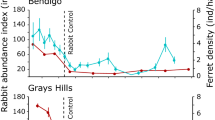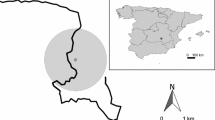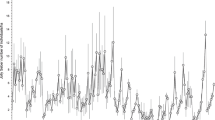Abstract
A population of 126 adult rabbitbrush (Chrysothamnus nauseosus var. consimilis) was followed for 10 consecutive years from 1983 through 1992 in a sanddune ecosytem on the north shore of Mono Lake, California. The study area received an average (1981–1992) of 160 mm total annual precipitation of which 55 mm fell from April through October, making this site drier than other known sites in the Great Basin desert where C. nauseosus occurs. Cover of all shrubs was 18.0%, and that of C. nauseosus 7.5%, in the 3077 m2 study plot. Water was limiting for this population of C. nauseosus, exerting large effects on new canopy growth and reproductive effort in a given year, on survival, and on establishment of juveniles into the adult population. Growth and survivorship of the adult shrubs were significantly correlated with the depth to ground water, which varied from 3.6 to 6.0 m below the surface during the study, and not with any measure of precipitation in a given year or adjacent years. Shrubs in this population exhibited a net decrease in size between 1983 and 1992. The region experienced a significant drought from 1987 onwards, with some increase in precipitation after 1990. Mortality of shrubs began in 1987 and reached 22% by 1992. Individuals that died were smaller on average initially than individuals surviving throughout the study: 50% or more of the individuals having 4000 cm2 of canopy or less at the start of the study died by 1992. Elevation (m msl) of each shrub in the study area, presumably correlated with depth to ground water, had no effect on growth but a weak effect on survival during the study period. Specific microsite had significant effects, with shrubs on steep slopes being smaller, having more negative “growth” slopes, and being more likely to die during the drought compared to individuals occurring on flatter gradients. Recruiment of juveniles into the population did not occur after 1985. Competition between shrubs could not be definitively demonstrated during the study, but only indirect tests for competition were used. Adult C. nauseosus and adults of all species combined (Sarcobatus vermiculatus with 9.6% cover, Tetradymia tetrameres with 0.8% cover and Chrysothamnus viscidiflorus with 0.02% cover) were randomly distributed, failing to support the hypothesis of competition if competition for water results in a uniform distribution of shrubs. Moreover, comparison of the spatial dispersion of C. nauseosus individuals before (1985) and after (1992) mortality did not reveal competitive thinning toward uniformity. On the other hand, larger individuals were farther from their nearest neighbor than were smaller individuals, an effect postulated to result from competitive thinning.
Similar content being viewed by others
References
Anderson DJ (1971) Pattern in desert perennials. J Ecol 59: 555–560
Barbour MG (1973) Desert dogma reexamined: root/shoot productivity and plant spacing. Am Midl Nat 89:41–57
Beatley JC (1980) Fluctuations and stability in climax shrub and woodland vegetation of the Mojave, Great Basin and transition deserts of southern Nevada. Isr J Bot 28:149–168
Blevins ML, Coufal EL, Watanabe L, Garcia MR, Foley CJ, Jimenez LC (1987) Mono Basin geology and hydrology internal report. Los Angeles, Department of Water and Power, Aqueduct Division-Hydrology Section
Bowers JE (1982) The plant ecology of inland dunes in western North America. J Arid Environ 5:199–220
Bradshaw AD, Chadwick MJ (1980) The restoration of land, University of California Press, Berkeley
Branson FA, Miller RF, McQueen IS (1976) Moisture relationships in twelve northern desert shrub communities near Grand Junction, Colorado. Ecology 57:1104–1124
Caldwell MM, Richards JH, Johnson DA, Nowak RS, Dzurec RS (1981) Coping with herbivory: photosynthetic capacity and resource allocation in two semi-arid Agropyron bunchgrasses. Oecologia 50:14–24
Clark PJ, Evans FC (1954) Distance to nearest neighbor as a measure of spatial relationships in populations. Ecology 35:445–453
Dileanis PD, Groeneveld DP (1989) Osmotic potential and projected drought tolerance of four phreatophytic shrub species in Owens Valley, California. In: Hydrology and soil-water-plant relations in Owens Valley, California. US Geological Survey Water Supply Papers, no. 2370
Dobrowoloski JP, Caldwell MM, Richards JR (1990) Basin hydrology and plant root systems. In: Osmond B, Hidy G, Pitolka L (eds) Plant biology of the basin and range. Springer, Berlin Heidelberg, New York, pp 243–292
Donnelly KP (1978) Simulations to determine the variance and edge effect of total nearest-neighbour distance. In: Holder I (ed) Simulation studies in archeology. Cambridge University Press, Cambridge, pp 91–95
Donovan LA, Ehleringer JR (1991) Ecophysiological differences among juvenile and reproductive plants of several woody species. Oecologia 86:594–597
Donovan LA, Ehleringer JR (1992) Contrasting water-use patterns among size and life-history classes of a semi-arid shrub. Funct Ecol 6:482–488
Donovan LA, Ehleringer JR (1994) Water stress and use of summer precipitation in a Great Basin shrub community. Funct Ecol 8:289–297
Donovan LA, Mausberg J, Ehleringer JR (1993) Seedling size and survival for Chrysothamnus nauseosus. Great Basin Nat 53:237–245
Ebert TA, McMaster GS (1981) Regular pattern of desert shrubs: a sampling artefact J Ecol 69:559–564
Fonteyn PJ, Mahall BE (1978) Competition among desert perennials. Nature 275:544–545
Fonteyn PJ, Mahall BE (1981) An experimental analysis of structure in a desert plant community. J Ecol 69:883–896
Ganskopp DC (1986) Tolerance of sagebrush, rabbitbrush and greasewood to elevated water tables. J Range Manage 39: 334–337
Groeneveld DP (1988) Shrub rooting and water acquisition on threatened shallow groundwater habitats in the Owens Valley, Calfornia. In: Symposium on cheatgrass invasion, shrub dieback, and other aspects of shrub biology and management. General technical report INT-276, Intermountain Research Station, US Department of Agriculture, Forest Service, pp 221–237
Groeneveld DP, Crowley DE (1988) Root system response to flooding in three desert shrub species. Funct Ecol 2:491–497
Jenkins SH (1975) Food selection by beavers: a multidimensional contingency table analysis. Oecologia 13:413–417
Jones and Stokes Associates (1993) Environmental impact report for the review of Mono Basin water rights of the City of Los Angeles. Draft. May (JSA 90–171). Prepared for California State Water Resources Control Board, Division of Water Rights, Sacramento, California
Klepper B, Rogers LE, Hedlund JD, Schreckhise RG (1978) Radiocesium movement in a gray rabbit brush community. In: Adriano DC, Brisbin IL Jr (eds) Environmental chemistry and cycling processes. Technical Information Center, US Department of Energy, pp 725–737
Lebreton JD, Pradel R, Clobert J (1993) The statistical analysis of survival in animal populations. Trends Ecol Evol 8:91–95
MacMahon JA (1979) North American deserts their floral and faunal components. In: Perry RA, Goodall DW (eds) Aridland ecosystems: structure, functioning and management. Cambridge University Press, Cambridge, pp 21–82
MacMahon JA, Schimpf DJ (1981) Water as a factor in the biology of North American desert plants. In: Evans DD, Thames JL (eds) Water in desert ecosystems. Dowden, Hutchinson and Ross, Stroudsberg, pp 114–171
Manning SJ, Barbour MG (1988) Root systems, spatial patterns, and competition for soil moisture between two desert subshrubs. Am J Bot 75:885–893
Manning SJ, Groeneveld DP (1989) Shrub rooting characteristics and water acquisition on xeric sites in the western Great Basin. In: Symposium on cheatgrass invasion, shrub dieback, and other aspects of shrub biology and management. General technical report INT-276, Intermountain Research Station, US Department of Agriculture, Forest Service, pp 238–244
Pavlik BM (1980) Patterns of water potential and photosynthesis of desert dune plans, Eureka Valley, California. Oecologia 46:147–154
Pielou EC (1962) The use of plant-to-neighbor distances for the detection of competition. J Ecol 50:357–367
Rogers DB, Dreiss SJ, Groeneveld DP (1992) Near-shore groundwater: and salt-flat processes at Mono Lake, California. In: Hall CA Jr, Doyle-Jones V, Widawski B (eds) The history of water: eastern Sierra Nevada, Owens Valley, White-Inyo Mountains. White Mountain Research Station Symposium, vol 4. University of California, Los Angeles, pp 367–395
Shreve F, Hinckley AH (1937) Thirty years of change in desert vegetation. Ecology 18:463–478
Smith AP (1979) Spacing patterns and crown size variability in an Ecuadorian desert shrub species. Oecologia 40:203–205
Solbrig OT, Orians GH (1977) The adaptive characteristics of desert plants. Am Sci 65:412–421
Sorenson SK, Dileanis PD, Branson FA (1989a) Soil water and vegetation responses to precipitation and changes in depth to ground water in Owens Valley, California. US Geological Survey Open-File Report, no. 89-260
Sorenson SK, Miller RF, Welch MR, Groeneveld DP, Branson FA (1989b) Estimating soil matric potential in Owens Valley, California. Hydrology and soil-water-plant relations in Owens Valley, California. US Geological Survey Water Supply Papers, no. 2370
Stine S (1990) Late Holocene fluctuations of Mono Lake, eastern California. Palaeogeogr, Palaeoclimatol, Palaeoecol 78:333–381
Toft CA (1983) Community patterns of nectivorous adult parasitoids (Diptera, Bombyliidae) on their resources. Oecologia 57:200–215
Toft CA (1984) Activity budgets in two species of bee flies (Lordotus: Bombyliidae, Diptera): a comparison of species and sexes. Behav Ecol Sociobiol 14:287–296
Toft CA (1989) Population structure and mating system of a desert bee fly (Lordotus pulchrissimus: Diptera, Bombyliidae). 2. Female demography, copulations and characteristics of swarm sites. Oikos 54:359–369
Toft NL, Anderson JE, Nowak RS (1989) Water use efficiency and carbon isotope composition of plants in a cold desert environment. Oecologia 80:11–18
West NE, Rea KH, Harniss RO (1979) Plant demographic studies in sagebrush-grass communities of southeastern Idaho. Ecology 60:376–388
Yeaton R, Cody M (1976) Competition and spacing in plant communities: the northern Mojave desert. J Ecol 64:689–696
Author information
Authors and Affiliations
Rights and permissions
About this article
Cite this article
Toft, C.A. A 10-year demographic study of rabbitbrush (Chrysothamnus nauseosus): growth, survival and water limitation. Oecologia 101, 1–12 (1995). https://doi.org/10.1007/BF00328893
Received:
Accepted:
Issue Date:
DOI: https://doi.org/10.1007/BF00328893




